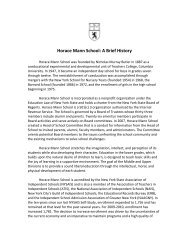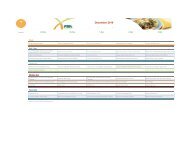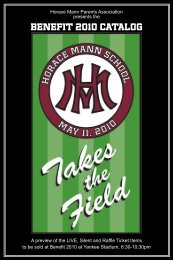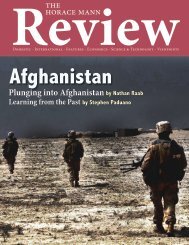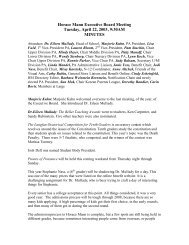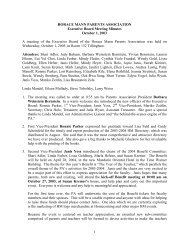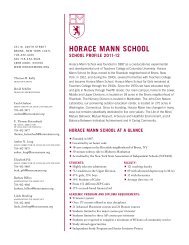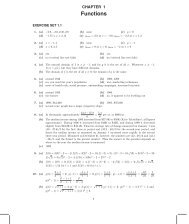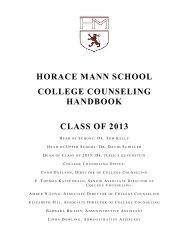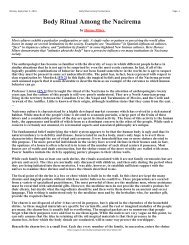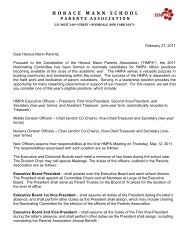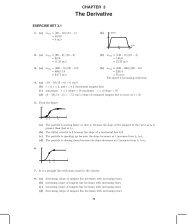horace mann school's publication for gender issues
horace mann school's publication for gender issues
horace mann school's publication for gender issues
Create successful ePaper yourself
Turn your PDF publications into a flip-book with our unique Google optimized e-Paper software.
An Interview With Wendy Cromwell<br />
Interview Conducted by Sinclaire Marber<br />
<strong>horace</strong> <strong>mann</strong> arts<br />
Wendy Cromwell, Horace Mann Class<br />
of 1982, is the President of Cromwell Art,<br />
LLC, a private advisory firm that specializes<br />
in 20th and 21st century art. Having served<br />
previously as a Vice President of Sotheby’s,<br />
New York, and as the director of Lehman<br />
Brother’s art collection, Ms. Cromwell is<br />
a veteran of the corporate art industry.<br />
Ms. Cromwell also has a long history of<br />
involvement in various museums and nonprofit<br />
organizations, such as ArtTable, Inc.,<br />
the largest professional organization <strong>for</strong><br />
women in the arts. In an interview with<br />
Folio 51, she reflects upon her experiences as<br />
a woman at HM and later in the art industry.<br />
SM: Did you take art history classes in<br />
high school If so, did you notice a <strong>gender</strong><br />
imbalance in the classroom<br />
WC: I took AP Art History at HM. It was<br />
a great class, taught by Don Yates. Unlike<br />
other classes, which were taught by HM oldtimers,<br />
Don’s classroom was progressive.<br />
It was discussion based, and I never felt<br />
any <strong>gender</strong> bias. Don was undeniably cool<br />
compared to the older generation of staff -<br />
he was openly gay, <strong>for</strong> starters, which was<br />
not the norm in 1981. At the end of the year<br />
he invited us to his loft in the West Village.<br />
I had never ventured to 11th avenue during<br />
the day, let alone at night - a different scene<br />
in those days. I was treated like an equal, and<br />
I discovered that I was meant <strong>for</strong> art history<br />
thanks to that class.<br />
SM: Do you remember there being a<br />
<strong>gender</strong> bias towards males when you were a<br />
student at Horace Mann If so, did you look<br />
at this as something to overcome and did<br />
your ability to overcome this affect your later<br />
career If not, was it an adjustment entering<br />
a field populated with many high-powered<br />
men<br />
WC: I only encountered <strong>gender</strong> bias in<br />
a few classes taught by a handful of older<br />
teachers, holdovers from the days when<br />
HM was an all boys school. In general, boys<br />
were more outspoken in the classroom, and<br />
those types of teachers tended to call on just<br />
the boys. Maybe it was a self-perpetuating<br />
problem - if I had been more aggressive<br />
about speaking up, it wouldn’t have been<br />
a problem. I was lucky to have a female<br />
teacher, Dr. Liana, <strong>for</strong> AP English senior<br />
year. She was a graduate of Smith, an all<br />
women’s college, and she was instrumental<br />
in helping me to choose that school over<br />
Middlebury.<br />
I owe much to Smith. I found my voice<br />
there, as a student. And I found my career<br />
there, through the vast network of female<br />
professionals. I must say that Smith was a<br />
welcome relief from the male dominated<br />
HM environment. For the first time, I<br />
consistently participated in class discussions.<br />
I remember feeling freed from the stuffy<br />
HM environment - it wasn’t just some of<br />
the teachers, it was also my peers - there<br />
was a culture of elitism within my HM class,<br />
mostly from the top male students, that<br />
repulsed me.<br />
At Smith, it was assumed that we would<br />
become achievers or leaders in some way.<br />
There was no pressure: it was simply in the<br />
culture. Without men in the classroom,<br />
there were no obstacles, no distractions, we<br />
were surrounded by positive rein<strong>for</strong>cement<br />
and amazing opportunities. I was lucky to<br />
have access to a strong professional network<br />
of Smith grads in the arts. Sophomore year,<br />
I got an internship at Leo Castelli gallery -<br />
the Director was a Smith alum. To be in<br />
the center of where it was all happening in<br />
1984 was an incredible opportunity, one I<br />
still treasure. The art world didn’t seem male<br />
dominated then. Sure Leo was the king, but<br />
Ileana Sonnabend was upstairs running her<br />
gallery, Paula Cooper was doing the same<br />
and Mary Boone was competing head to<br />
head with Leo. I don’t see the art world as<br />
dominated by powerful men, even though<br />
my teachers at the Institute [of Fine Arts,<br />
where Cromwell earned a masters degree]<br />
were Kirk Varnedoe and Bill Rubin - the<br />
most powerful men in the art world, both at<br />
MoMA at the time (now deceased).<br />
SM: After working at Sotheby’s and other<br />
significant art related jobs, what prompted<br />
you to go into business <strong>for</strong> yourself<br />
WC: When I started at Sotheby’s, I was<br />
interviewed by the CEO, Dede Brooks. She<br />
asked me what I wanted to be in 10 years<br />
time- I said “you.” This response came<br />
naturally to me - it had nothing to do with<br />
Horace Mann, and everything to do with<br />
Smith. Later, she was caught up in the<br />
price fixing scandal between Christie’s and<br />
Sotheby’s. I actually felt betrayed and let<br />
down by her behavior - women have to hold<br />
themselves to a higher standard because<br />
they are such easy targets as corporate CEO’s<br />
(compared to the bad behavior of so many<br />
men who led us into our current depressed<br />
economic circumstances). Sotheby’s<br />
definitely suffers from a male-dominated<br />
leadership that is not kind to women,<br />
although women populate the ranks at every<br />
level of the company. I had always worked<br />
there as a means to an end - I knew from my<br />
days at Lehman Bros that I wanted to be an<br />
art advisor. Sotheby’s opened many doors<br />
<strong>for</strong> me. I learned how markets were made<br />
and became well versed in art from 1945 to<br />
the present. After nine years at Sotheby’s, it<br />
was time to start my own business.<br />
WC: One last thing. I come from a<br />
line of strong, independent women. My<br />
grandmother, who was born in Hungary,<br />
wanted to be a Dr. from the time she was<br />
10 years old. Jews were not allowed to enter<br />
University in Hungary, She left home at the<br />
age of 19 to attend medical college in Berlin.<br />
My mother was born in Berlin. When my<br />
grandmother emigrated to the US, she<br />
passed another round of medical exams to<br />
become a U.S. Dr. She practiced pediatric<br />
medicine at NY Hospital <strong>for</strong> nearly 30 years.<br />
My mother has a PhD in modern European<br />
history from Columbia. She attended<br />
Hunter College High School and worked on<br />
Wall Street <strong>for</strong> over 25 years. She sent me to<br />
HM as a single parent. At the age of 70, she<br />
realized her life long dream of turning her<br />
PhD dissertation into a published biography;<br />
her book can be found in all the major<br />
libraries. I guess of all the people you could<br />
have asked about <strong>gender</strong> bias at HM, I would<br />
have been the least likely to be affected by it<br />
- I am <strong>for</strong>tunate to have been surrounded by<br />
such great female role models.<br />
17



